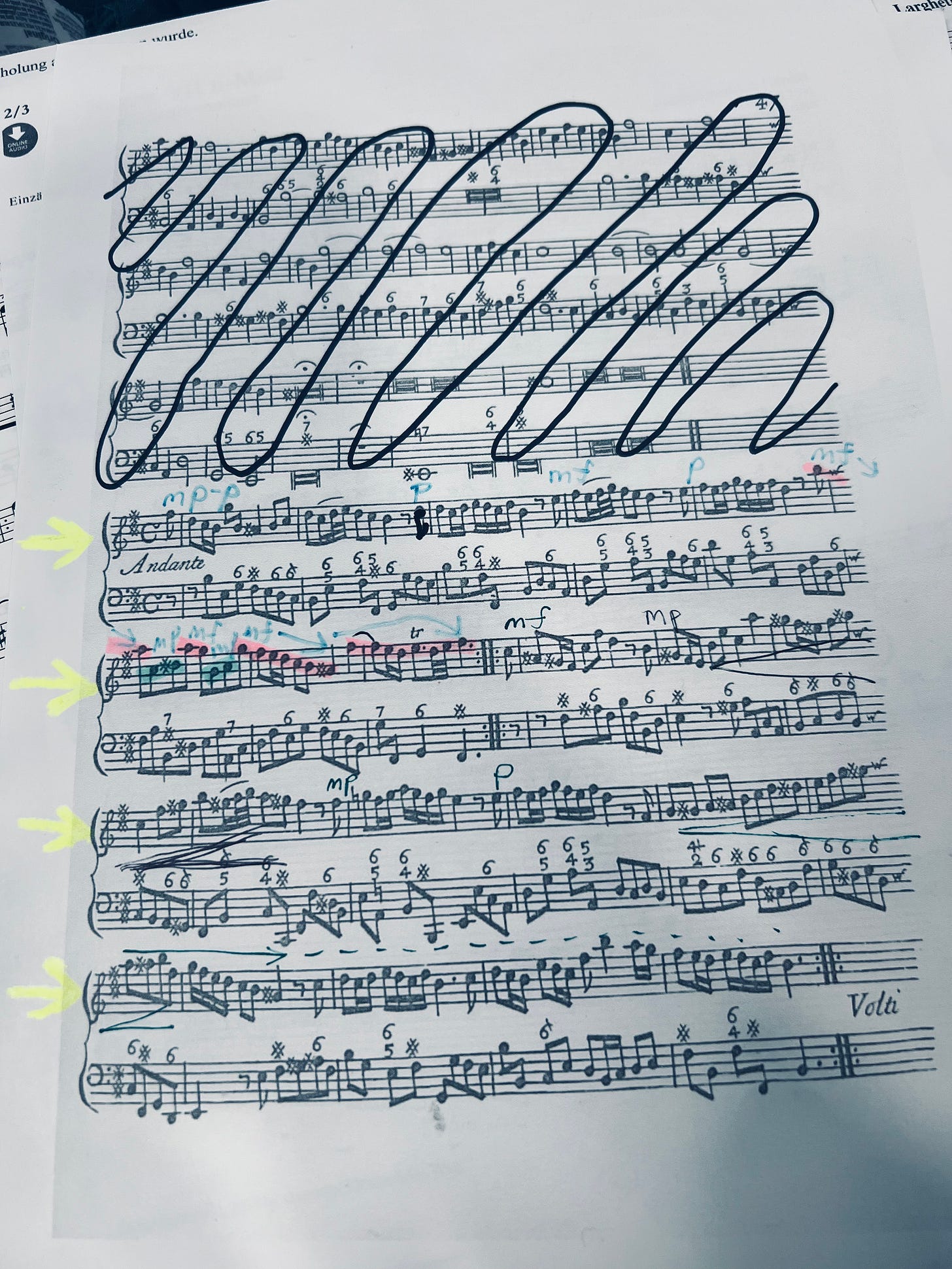Happy Valentines Day! I hope you’re all doing well. Honestly I can’t tell if I’m getting sick or just tired. There are certainly plenty of day-care illnesses going around at the moment. I haven’t decided if I will make a video today, but I’ll see how I feel as I type and warm-up on my flute (now you have a clear visual on my work-flow).
Last time I gave a quick introduction to the Andante. Have you tried playing through it yet? Seriously, let me know in the comments.
It’s totally fine if you have to play it at a reduced tempo.
However, I do think it’s time that we make some musical decisions about the dynamics… as you may have notice, there are no indications in the music. That’s very typical of Baroque music, especially if it is a “good” edition. If there were tons of editorial markings, we wouldn’t be able to erase them, would we? What we have in front of us is just a cleaner version of the facsimile. What I highly recommend is that you photocopy your music as you go so that you can make practice versions. One day you might want to play one phrase forte with a piano response, and the next you might want to do the exact opposite! Seeing as how we will also be adding some ornamentation as well, it might be nice to keep your book free of excessive markings. (I wish I had known better in college)
So let’s get into some ideas about the dynamics. These are just my ideas. You can copy them exactly or use them as a starting point if you’re not sure what to do. Remember that there are repeats, which means that you don’t have to play the piece the same way the second time around, in fact, it would be rather boring if the repeat was a literal repeat.
‘A’ Section (measures 1-8):
I like to start the piece with a semi-soft dynamic, so basically a mezzo-piano. Think intimate, warm, and inviting. I like the idea of starting even softer the second time through. After the ‘B’ in measure 2 (the deceptive cadence that I mentioned in my last post), are shorter statements that are continuations of the first idea. These little phrases go until the end of measure 5. You can really play around with the dynamics on these. I like the scheme piano, mezzo-forte, piano (scroll down to see a picture of my music). Then starting with the pickup at the end of measure 5, you have the beginning of a sequence with 5 ‘pairs’ of notes: B-A, C#-D#, A-G, B-C#, G-F#. You have the options of varying the dynamics here as well. You’ll notice that based on the register changes, these pairs are essentially two musical voices going back and forth, the top voice being a descending line B-A, A-G, G-F# and the lower voice being a little turn C#-D#, B-C#. You can be as obvious or subtle with this as you like, but for now I’m alternating between mezzo-forte and mezzo-piano. Once I play the last pair (G-F#), I maintain my mezzo-forte until the double bar-line for the simple fact that the notes after the G-F# continue past the pairing scheme to drive us to the cadence with a moment of repose on the final F# (it is a half-cadence for anyone reading this who might know a little bit of music theory).
‘B’ Section (measures 9-end):
Personally, I like to keep my dynamic full at the beginning of the B Section in order to get softer in the following measures. BUT, it would be just as valid to start a little softer before a build. To break it down, I play the first measure mf, the pickup to the next measure mp, then crescendo to the end of the phrase, which is the quarter note F# in measure 12 (notice that measure 11 begins on one line and is completed on the next). I then proceed to play gradually softer on the following two statements, then beginning a crescendo at the start of the long ascending line in measures 15 and 16. Once I reach my goal dynamic (let’s say forte), I keep my volume robust until the final note of the movement.

I think I’ll make a video for the next post—not because I feel too sick, but because I just had a snack 🤣. Let me know in the comments if you found these practice notes helpful.
I’ve decided not to add a paywall to this post, but if you’d like to receive more content like this, you should consider becoming a paid subscriber! It’s only $6 a month and you can even save a little more by paying annually.
Have a great weekend!





Extremely helpful comments, which I used in playing this in my practice session. Good to see your marked-up score too!